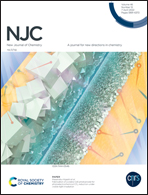Fabrication of a novel magnetic rubidium ion-imprinted polymer for selective separation
Abstract
With the increasing demand for rubidium resources, the development of adsorbents that can be simply, quickly, and selectively extracted is of great importance. In this study, a novel magnetic ion-imprinted polymer (MIIP) for Rb+ was synthesized by combining the surface imprinting technology with the magnetic separation technology. Polydopamine-coated magnetic graphite oxide was used as the basic skeleton material, and then modified with the silane coupling agent. Methacrylic acid and 18-crown-6 (18C6) were respectively used as the functional monomers and ligands with recognition ability, which were polymerized at the surface of the magnetic carrier. The chemical composition, structure, and properties of MIIP were characterized using Fourier transform infrared spectroscopy (FTIR), thermogravimetric analysis (TGA), scanning electron microscopy (SEM), transmission electron microscopy (TEM), and X-ray photoelectron spectroscopy (XPS). Furthermore, the optimal conditions of the adsorption behavior were explored. Also, the results displayed that the maximum adsorption capacity reached 186 mg g−1 in 400 mg L−1 Rb+ solution (pH = 10). The adsorption studies demonstrate that the adsorption behavior of MIIP corresponds to the Langmuir model and the process is surface reaction-controlled chemisorption. The synthesized MIIP shows promising selectivity in the competition of K+, Li+, Na+, Mg2+, and Ca2+. Moreover, MIIP still shows a high adsorption efficiency (>87%) after seven adsorption–desorption cycles, which indicates that the obtained magnetic imprinted polymer has excellent regeneration and stability.



 Please wait while we load your content...
Please wait while we load your content...